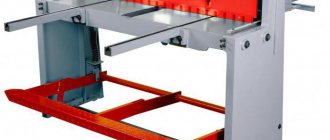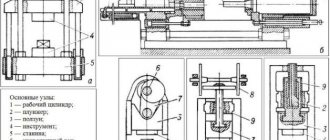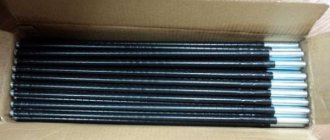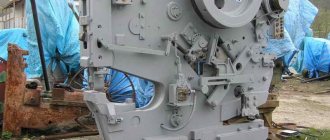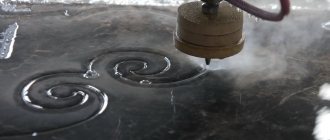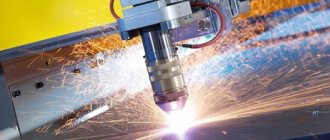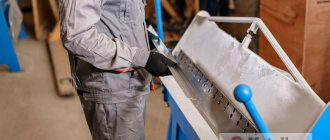Home » Reviews » Guillotines for metal cutting: types and applications
To cut metal sheets or rods, enterprises use special equipment. Guillotines and guillotine shears are needed in construction, mechanical engineering, manufacturing, car service centers and home workshops.
Similar scissors for cutting and chopping metal are produced in various variations. The types of this equipment will be discussed below. Devices with different types of drive differ in cutting accuracy, operating speed and other characteristics.
Russian metal cutting machines (guillotines) are selected based on technical characteristics. The most important of them is the maximum thickness of the sheet material that is planned to be cut. The weight of the scissors is equally important. These parameters and other technical parameters are indicated in the description of Guillotine shears in our catalog.
Pneumatic guillotine shears
Pneumatic scissors are distinguished by high cutting accuracy due to the increased rigidity and strength of the frame.
Pneumatic models are equipped with a compressor and operate using compressed air. Guillotines of this category are distinguished by a large working surface. The equipment is very economical and is suitable for large enterprises that require constant operation of the metal cutting device.
Pneumatics perfectly cut thick sheets and cope with alloy steel.
The lubrication and electrical system of pneumatic shears of the HA series operates even at low temperatures, which is impossible when working with a hydraulic analogue.
Design and principle of operation
The electromechanical guillotine, a more common design, consists of the following components:
- electric motor;
- V-belt transmission;
- flywheel;
- receiving shaft;
- electro-pneumatic activation system: clutches and brakes;
- main shaft of two-crank type;
- two connecting rods of a pulling or pushing type;
- knife beam. back stop;
- front stop (for units working with thin sheet metal, this unit may be absent);
- desktop;
- clamp;
- welded type beds (in older models of machines there are cast beds);
- working rail cart for collecting cut strips;
- lubrication and control systems.
Industrial versions of mechanically driven sheet metal cutting machines operate in the following sequence. The sheet metal to be cut is set along the back stop to a certain cutting width. In this case, the knife beam is in its uppermost position, the electric motor and flywheel with the receiving shaft rotate, but the beam is motionless, since the brake is on. After positioning the workpiece along the back fence, the operator turns on the front fence, which sets the required cutting accuracy. Next, the clamp is turned on. It is a set of pneumatic or hydraulic cylinders of small working diameters, which with their rods press the sheet metal to be cut to the supporting surface of the table. When the scissors are turned on, the brake is unlocked and the clutch is simultaneously engaged, which connects the main shaft to the receiving shaft. The main actuator performs a forward stroke, at the end of which a complete separation is performed. When the beam returns to its original position, the back stop rotates and releases the cut strip. As a result, it falls along the slide into the cart behind the machine, which is then manually or automatically removed from under the equipment. From the cart, a stack of cut strips is moved by a crane or conveyor to a warehouse or to a place of further processing. The last non-multiple strip is removed manually, while the cylinders of the clamping unit are equipped with protective covers that prevent the operator’s fingers from entering the working area (all scissors are controlled by pedals).
A mechanical guillotine for metal sometimes has a different design. The difference is that the connecting rods of such machines are not of the pulling type, but of the pushing type. They are located in the lower part of the knife beam, and during the working stroke they push it upward. It is believed that such a machine design is characterized by lower working loads on the connecting rods, and guillotine shears with pushing connecting rods have a lower height. This scheme, however, is more complex in routine maintenance and adjustment, and therefore is more typical for machines working with workpieces of small thickness - up to 1.5...2 mm.
Electromechanical machines for metal cutting
Mechanical guillotine shears are in demand at enterprises that specialize in cutting sheet metal. Equipment of this class is characterized by a low price, optimal performance, and is used to perform the entire range of tasks associated with cutting rolled metal in production.
The system is powered by an electric motor. The machine is connected to the network to supply energy. Such devices are distinguished by high speed, efficiency, and cutting accuracy. When cutting, the knife acts evenly on both sides of the sheet. The service life of electromechanical type guillotines is long.
The length of the table and the size of the sheet workpiece depends on the model and assumes a width of 2000, 2500 and 3000 mm.
Guillotine for cutting metal: manual, hydraulic, electromechanical, pneumatic
Cutting metal products on a guillotine is a straightforward method of cutting rolled steel sheets into rolls, strips and rectangular and square pieces.
There is practically no waste when cutting with a guillotine (a small amount of small chips may remain on the knives). Cutting accuracy - 0.05-0.1 mm. Work speed - more than 10 workpieces per 60 seconds (depending on the type of equipment).
Metalworking technologies such as chopping and cutting should not be confused, because they have significant differences.
Chopping and cutting metal
Steel blanks are cut by the impact of a chisel (sharp cutter), which is located at a slight angle or strictly perpendicular to the rolled metal. The tilt of the working tool is controlled by the master, since the presented method is carried out manually.
The manual cutting method is familiar to people working in production, private craftsmen, and car owners. It is applicable in cases where it is necessary:
- adjust the workpiece to the required size;
- process the edges of metal products;
- level a flat surface;
- remove the formed burrs;
- form edges for further welding of rolled metal;
- separate the resulting scale;
- punch a hole in the workpiece;
- cut off the heads of fasteners (for example, bolts).
The chisel has a sharpened tip. It allows you to cut metal, make grooves, recesses, and holes in the workpiece.
It is made from tool alloys or carbide structural plates. Outwardly it looks like a steel bar, on one side of which there is a cutting edge. Depending on the purpose, it varies in shape, width of the working part and sharpening angle.
Traditionally, tools with a width of 2-2.5 cm are used. The cutting edge is flat or slightly rounded. When working with steel raw materials, the sharp part of the chisel becomes dull over time. The cutting element is sharpened taking into account the required angle. For work:
- with bronze and cast iron the parameter of 70 degrees is observed;
- ordinary steel - 60 degrees;
- copper and brass - 45 degrees.
An analogue of a chisel is a crossmeisel. Usually its cutting part does not exceed 1 cm, the shape of the working surface is teardrop-shaped. It is more often used to create grooves and grooves on the surface of a metal product, while the chisel is used more for through cutting through rolled metal.
When chopping by hand, a hammer acts as an additional tool. For work, select a standard locksmith tool weighing 0.4-0.8 kg and handle length from 35 to 45 cm.
The process of cutting metal using a chisel consists of the following steps:
- the workpiece is placed on a flat and durable surface or an anvil (more often it is clamped in a vice);
- a marking line is made;
- A chisel is placed vertically at the cutting site;
- the master applies light blows with a hammer to the top of the chisel, which in the process moves slightly along the marking line;
- the steel billet is turned over;
- all actions are repeated on the reverse side.
But cutting can be not only vertical, but also horizontal. In this case, the workpiece is clamped in a vice at an angle of 35 degrees or less relative to the table. This method allows you to chop off the excess part of the rolled sheet protruding from the vice.
As an alternative, hand held metal shears have recently been used instead of chisels. But in both the first and second cases, the edge of the workpiece may have roughness, burrs, and unevenness.
But cutting metal with a guillotine gives an even cut. But this type of metalworking no longer refers to cutting, but to cutting. The workpieces are cut using sawing and cutting tools (scissors, saws, automated modern equipment). This is a more modern method, used mainly in small and large enterprises.
How to cut metal on a guillotine
A guillotine for cutting metal is a machine that is equipped with a static cutting element located at the bottom, as well as an upper knife (it moves along a certain path: arc-shaped or just straight, depending on the type of machine). Some types are equipped with an additional press, which allows you to fix the workpiece on the bed.
A characteristic feature of such installations is the oblique knife beam located on top. This helps it gradually move towards the cut line while applying pressure to the rolled metal sheet.
This type of knife also affects the power of the mechanism, which is capable of cutting through steel up to 20 mm thick with one blow. But the recommended parameters for workpieces are still sheets from 0.1 to 2.5 mm. In this case, the strength of the metal can reach 500 MPa.
Knives are produced in one piece. They are made mainly from steel grades U8A and U10A (after heat treatment they should have a hardness in the range of 56-58 HRC), as well as X12, 4ХС, 6ХС, 5ХВ2С, Х12Ф1 (their hardness is 56-62 HRC).
The cutting process consists of the following stages:
- the workpiece is fed to the work table. This is done manually or automatically (depending on the type of machine);
- the steel sheet is fixed to ensure high quality cutting;
- the dimensions of future tapes or strips are determined;
- the locations of the incisions are indicated;
- a steel knife sharpened at an optimal angle (on average from 86 to 89 degrees) is lowered onto the laid rolled metal;
- with its own weight or with the help of a hydraulic, electromechanical drive, it acts on the workpiece with the force necessary for cutting;
- once the cut is made, the knife is raised.
In industrial conditions, equipment with long knives is used, which increases cutting speed, increases productivity and makes it possible to cut rolled metal with a width of more than 3 meters. At large enterprises, machines with guillotine shears are installed, which are capable of cutting 6-meter rolled products.
What metal is cut on a guillotine?
The guillotine machine is used for cutting cold-rolled and hot-rolled metal. You can also chop:
- galvanized steel;
- blanks made of stainless alloys;
- composite materials;
- smooth and corrugated aluminum;
- non-ferrous types of metals (copper, titanium, brass).
As we said above, the thickness of the workpieces can be in the range of 0.2-1.5 mm. The guillotine cuts steel with a strength of up to 400 MPa. In industrial conditions, workpieces 2 meters long are cut as standard. At large enterprises it is possible to cut sheets 3-6 meters long. The cutting accuracy does not exceed 0.1-0.2 mm.
Equipment Features
A standard guillotine for cutting sheet metal consists of:
- from a fixed frame (work table);
- right and left racks;
- clamping beam part;
- knife type beams;
- back stop;
- crank;
- shear plate;
- knife feed lever (can be manual or automatic).
Depending on the type of equipment, this equipment can be supplemented.
Guillotine for cutting metal is:
- manual. Used in small workshops. The workpiece is cut by two installed knives. The lower one is fixed in one position, and the upper one moves strictly vertically downwards. The manual guillotine does not require adjustment. It is only important to install the equipment on a flat surface and align the knives according to the factory diagrams. Cuts relatively small workpieces (cut width usually does not exceed 1200-1500 mm). Used for steel up to 0.5-0.7 mm thick. Popular models: Mazanek GR 2000, Schechtl HT 200, Q01-1.25×2000;
- hydraulic. They are equipped with a hydraulic drive system. Performs both piece and serial processing of metal sheets. The hydraulic guillotine works with sheet metal up to 2 cm thick and no more than 6 meters long. The knives can move in a straight or arcuate path. Control over their location is carried out in manual, automatic, and semi-automatic mode. Particularly popular: Stalex HQ, Stalex THS, MelalMaster HCJ;
- electromechanical. It is used in large enterprises where high productivity and the ability to cut thick sheet metal are important. The knife works thanks to a crank mechanism. The equipment can be equipped with CNC. This allows you to create templates for the production of large batches of workpieces of the same type and increase cutting accuracy. An electromechanical guillotine cuts metal with a cross section of 4-8 mm. The knife makes up to 60 moves in one minute. Popular models: Fabtec Q11, RAS SMARTCUT, RAS PRIMECUT, SAY-MAK SRGM-H;
- pneumatic The entire mechanism operates on a compressed air line. The productivity of this type of equipment is higher than that of a hydraulic machine. Most often, the pneumatic guillotine is used in enterprises with large-scale production of metal products. The knife cuts metal with a thickness of 12 mm or more. The TGSP machine model is especially popular.
Industrial guillotines
Productivity and minimization of time costs when cutting with a guillotine play a major role when choosing equipment for large enterprises. Therefore, in industrial settings, pneumatic, hydraulic or electromechanical equipment is mainly used. Large producers place emphasis on complete automation of the process. The main part of the machines is equipped with CNC.
Among the popular types of guillotines for cutting metal, we highlight:
- MetalMaster hydraulic units;
- Stalex electromechanical guillotines;
- Inanlar hydraulic shears;
- pneumatic machines TGSP;
- electromechanical scissors TKS, etc.
Hydraulic shears Inanlar
Comparative table of all types of guillotines, GOST standards, types of defects
| Guillotine type | Thickness of metal products | Type of metal product | Maximum strength of the metal workpiece | Sheet width | Number of moves in 60 seconds | Availability of CNC | Cutting accuracy |
| Manual | 0.2 – 1.5 mm | Galvanized and profiled sheets, fittings, ordinary sheet metal | 400 MPa | 0.1-2.5 m | from 2 to 5 | — | 0.05-0.1 mm |
| Hydraulic | 0.4 – 40 mm | Fittings, corrugated sheets, steel made of aluminum, titanium, galvanized, stainless and ferrous metal | 500 MPa | 1-3 m | from 8 to 20 | + | 0.05-0.1 mm |
| Electromechanical | 0.25 – 12 mm | Fittings, corrugated sheets, steel made of aluminum, titanium, galvanized, stainless and ferrous metal | 500 MPa | 1-3 m | from 1 to 60 | + | 0.05-0.1 mm |
| Pneumatic | 0.2 – 12 mm | Fittings, corrugated sheets, steel made of aluminum, titanium, galvanized, stainless and ferrous metal | 500 MPa | 1-2.5 m | from 1 to 60 | + | 0.05-0.1 mm |
Work with guillotine equipment is controlled by GOSTs 6282-88, 11647-75.
Among the possible types of marriage, we highlight:
- oblique cut and crescent shape (explained by the blade moving to the side due to weak tension in the frame);
- formation of a sharp edge on a metal product. Reasons: poor quality of sharpening of the guillotine knife or incorrect location of the upper cutting element on the machine;
- curvature or twisting. This can happen due to poor quality or incorrect clamping of the workpiece.
Advantages of guillotine cutting
- Fast payback.
- Complete readiness of the workpiece for further processing after the cutting process;
- Versatility (you can work with rolled sheets of various alloys, including cold and hot rolled steel, stainless steel, galvanized).
- Economical. Cutting metal using a guillotine results in minimal losses of the starting material (no more than 10%). This method allows you to cut sheets with virtually no sawdust or shavings.
- Cut quality. The edge is smooth, without burrs, creases or chips. The knife is lowered strictly perpendicular to the workpiece.
- No heating of the material.
Application
In industrial conditions, other types of metal cutting are also used. It could be:
- waterjet method. Cutting accuracy – 0.1 mm, cutting width – 0.8-1 mm, minimal material loss (possible tolerances 0.1-0.3 mm);
- band saw cutting. Accuracy - 0.1 mm, width - about 1.5 mm, material loss is minimal (possible tolerances 0.1-0.3 mm);
- laser cutting method. Accuracy – ±0.05 mm, width – 0.2-1 mm, material loss is small (possible tolerances 0.1 mm);
- plasma cutting. The cutting accuracy is ±0.1 – ±0.5 mm (depending on the type of material), the cutting width is 2-7 mm, the loss of material is relatively high (possible tolerances are 0.2–0.5 mm).
Guillotine cutting is used primarily to create steel sheets, strips and strips of specific sizes.
These metal products are subsequently used in construction and in the production of parts for cars, work machines, and industrial machines. The resulting metal products are also used in aircraft, ship, and car construction.
Hydraulic guillotine shears
Hydraulic guillotines are used by large enterprises. These devices are used in the automotive industry and in the production of roofing materials.
Machines in this category are the most modern and productive. They are distinguished by their long cutting length, high power, productivity and efficiency. If you need a system that can easily cut a sheet 2.5 cm thick, then you should pay attention to these machines. Their cutting length reaches 3 meters.
The guillotine can be equipped with pedal and manual control, graduated stops for cutting high-precision workpieces, CNC and a number of additional options. A distinctive feature of this equipment is its high cutting accuracy and the absence of nicks and dents. Hydraulic guillotine shears are used for cutting without defects or damage the covering layer of metal with a polymer or paint coating.
Electromechanical guillotines
The main characteristics of the electromechanical guillotine are cutting thickness and working length. guillotines are a fast and affordable solution using the most modern technologies. The main characteristics of a guillotine are cutting thickness and working length. guillotines are a quick and affordable solution using guillotine shears, press shears are most often used in blank production for cutting metal sheets of various widths, lengths and thicknesses into workpieces of the required sizes.
Guillotine shears are widely used in the production of furniture and interior items made of metal (doors, arches, cabinets, trailers and carriages, gazebos, hangars, safes). And powerful electrically driven guillotines, which can cut metal over a wider range, are in demand in the manufacture of complex machine tools in the mechanical engineering and military-technical industries. TAPKO-M also presents press shears, which are used for cutting holes and squares in metal sheets.
Video review of the electromechanical guillotine Metal Master ETG 1330
Electromechanical guillotines (guillotine shears), compared to manual ones, are more powerful machines and, depending on the modification, allow cutting steel sheets up to 4.0 mm thick with a working length of 1040 mm. The drive in electromechanical guillotines is an electric gear motor. The engine power of various guillotine is from 2.2 kW to 3.7 kW, and the range of working lengths is from 1040 mm to 4540 mm. The maximum thickness of the cut steel sheet with a length of 4540 mm is 1.5 mm, aluminum 2.5 mm, stainless steel 1.0 mm. The most powerful models of electromechanical guillotines have a reinforced knife beam, and in its drive the eccentric is replaced by a crank mechanism. Changing the dimensions of cut parts in electromechanical guillotines is done by moving interconnected stops on the back side of the guillotine :
- using a manual drive from the front side;
- using an electromechanical drive with size indication;
- using software control.
An additional option for guillotine is the installation of a tilting pneumatic table, which throws the cut part either forward or back into the storage bin. Additional options serve to increase labor productivity, while simultaneously increasing the basic cost of the guillotine. Electric guillotines with program control have a memory device and programs for setting cutting sizes, taking into account the factor of sheet thickness and its strength characteristics, the number of parts in a batch and their movement from the cutting zone. The set of electromechanical guillotines may also include: increased resistance knives for cutting chromium steels, a storage trolley for 300 kg or 1000 kg, a receiving tray, an angle stop for cutting at a given angle, ball guides to the table, guides for rolled sheet metal, a contact stroke counter .
You can purchase electromechanical guillotines in the following cities: Moscow, St. Petersburg, Kazan, Samara, Yekaterinburg, Krasnodar, Krasnoyarsk, Novosibirsk, Minsk. At the regional offices of Tapko-m. We will always be glad to hear from you and will select equipment for you according to your requests.
CONSULTATION REQUIRED
Our operators will answer any questions: 8(800)555-30-72
Or leave your phone number:
Your order is accepted!
By clicking on the “Call me back” button, I consent to the processing of personal data.
Types of guillotine shears
There are many types of guillotine shears available. The equipment is distinguished by the type of drive, the shape of the working cutting tool, and technical parameters. The most common classification of devices is by type of drive. There are:
- Manual guillotines for cutting metal.
To increase the force, a long lever with a transmission mechanism is used. - Hydraulic equipment
. The power unit of the devices is a hydraulic system, which allows the development of force sufficient to cut thicker metal. - Pneumatic shears
. Equipment of this type is installed on profiling and other machines, as well as separately. A compressor is required to operate the shears. - Electromechanical
. An electric motor is used to drive such equipment. To increase the cutting force, gearboxes are used.
Let's consider the design of each type of guillotine shears and the scope of application of the equipment.
Manual guillotine shears
Manual guillotine shears are used in piece or small-scale production. The equipment consists of:
- From the frame on which the remaining equipment components are fixed.
- From a work table to place the workpiece, a clamping fixture can also be placed on the table.
- From a lever or foot drive to develop force and transfer it to the cutting tool.
- From movable and fixed knives for cutting metal.
Manual guillotine MOBIPROF for radius cutting
Models with long cutting lengths are made on 2 stands. The operating principle of such machines is no different from other guillotine shears. To increase the force transmitted to the knives, the design includes a transmission mechanism with a gearbox.
Manual guillotine shears are used for cutting metal from 0.35 to 4 mm; there are models for cutting rolled products with a thickness of more than 10 mm.
Based on the type of knives, straight and shaped cutting equipment is distinguished. The first is used for direct cutting of metal. Radius cutting scissors allow you to cut profiled workpieces. Due to the shape of the knives, such products are not damaged.
The main advantages of manual equipment are low price, ease of maintenance and repair. The equipment is used in workshops, workshops, directly on construction sites, that is, wherever it is suitable in terms of technology and productivity.
Hydraulic guillotine shears
Hydraulic guillotines for metal cutting are designed for serial and mass production, as well as cutting metal of considerable thickness. A hydraulic pump with an electric motor is used to drive the equipment.
Hydraulic guillotine MOBIPROF
Hydraulics allow you to develop significant forces; hydraulic shears cope with thick rolled metal and a large volume of work. Smooth movement of the knife along the entire length of the workpiece ensures high quality cutting lines. Due to the smooth action and significant force, a high-quality cutting line is obtained, without sharp protrusions and burrs.
The equipment can be equipped with:
- CNC unit for automated production.
- Laser illumination of the cutting line.
- Precise servos.
- Hydraulic or pneumatic clamping system.
- Automatic or semi-automatic feeding systems for sheet or coil metal.
Hydraulic guillotines for metal cutting are also equipped with photo sensors, automatic locking and other modern safety systems. Computer-controlled machines can work in conjunction with other equipment, allow you to set the sizes of segments, and count the number of workpieces.
Electromechanical guillotine shears
Electromechanical equipment for guillotine cutting of metals is intended for small-scale, serial and mass production. The equipment is driven by an electric motor with a gearbox.
Machines of this type can also be equipped with automated control units, as well as:
- Illuminated cutting line.
- Pressing devices of various types.
- Modern operator safety systems.
- Devices for feeding and receiving metal sheets.
- Foot pedal for turning on when manually feeding the workpiece.
The cutting force of electromechanical machines is less than that of hydraulic ones. Guillotine shears with such a drive are used for cutting metal of smaller thickness. The advantages of the equipment include high productivity and accuracy, the ability to coordinate work with other equipment.
Pneumatic guillotine shears
Pneumatically driven metal cutting equipment is used in small-, medium-scale and mass production. They produce models for installation on other machines, for example, profiling machines, as well as a separate installation.
Pneumatic guillotine MOBIPROF
Shears with pneumatic drive:
- Easily amenable to automation. On stand-alone machines you can install position sensors for knives and parts, CNC units for synchronization with other equipment and automated production.
- Develop significant effort. There are models of guillotine shears with pneumatic drive for cutting metal more than 10 mm thick.
The machines are also equipped with a remote control panel and security systems. Pneumatic equipment has high performance and can work with other machines and autonomously.
Guillotine shears
This section “GUILLOTINE SCISSORS” discusses the type of equipment used to cut sheet metal to the required overall characteristics (size). Those. Before you start producing a particular product, you will have the task of preparing the necessary blanks (component elements) to size. To solve this problem, a wide range of equipment is used, depending on the range and type of metal you use. In particular, one of the most common and indispensable subclasses of equipment used in the procurement and metalworking industry when working with sheet metal are machines such as guillotines or, more correctly, guillotine shears. Guillotines were used in office work long before our century, and since then it has been practically impossible to cut sheet metal, whether in serial or single production, without guillotine shears.
In order to understand the level of demand and necessity of this type of equipment, we will try to indicate at least some sheet metal products used in such industries as manufacturing, construction, agricultural, municipal or service industries: various configurations of boxes, tanks, casings, panels, additional and facing elements, signs and decorative overlays; all types of metal roofing and related additional elements, any types of construction auxiliary elements made of metal (beams, profile systems, gussets, cable channels, etc.); various ventilation and drainage systems for industrial and private use; typesetting elements for the construction of more complex, composite products made from sheet metal; facade and window additional elements (ridges, slopes, wind and cornice strips, ebbs, flashings, etc.).
Unfortunately, it is not possible to list all the items and products in the creation or production of which machines such as guillotine shears are involved, but we can safely say that practically no process of procurement and metalwork production will be full-fledged, excluding from it such a necessary type of equipment for cutting metal like a guillotine.
Despite the apparent simplicity of the functionality of a guillotine-type cutting machine, its structure and design includes a complex and very metal-intensive mechanism. As a rule, despite the many modifications of guillotine shears, a machine of this type includes the following main elements: a massive and rigid frame (machine bed), gear part (machine drive), flywheel (or eccentric in the manual version), table (with the ability clearance adjustment), upper running beam, clamping mechanism, knives (top and bottom), back stop, control system.
The main characteristics of guillotine machines in terms of the parameters of the material used are the width and thickness of rolled sheets, as well as the maximum and minimum sizes of the cut workpiece. Based on the type of drive device for guillotine machines, the following main subgroups can be distinguished: manual (foot), electromechanical, electrohydraulic and pneumatic. Due to their high metal consumption, guillotines are mainly intended for stationary use at production and construction sites, with rare exceptions when small models of guillotine machines imply in their design sufficient mobility and the ability to operate in various climatic conditions.
When approaching the issue of choosing a guillotine shears machine, you need to understand that this type of equipment, despite its apparent simplicity, is a rather specific and complex device, so you need to understand that the design and specific operation of the machine must fully comply with the parameters of your products, including overall dimensions the sheet used, as well as parameters characterizing the productivity of the work, the tolerance of dimensional deviations, the quality of the surface after the work is completed, the possibility of sorting chopped metal, the presence of automatic adjustment of the knife gap, etc. Taking into account all the requirements formed when choosing the felling equipment you need, you can easily select an indispensable assistant in your office work, thereby ensuring high productivity and rhythm of work.

